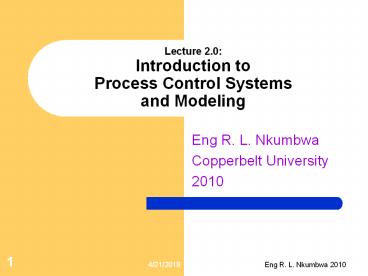Lecture%202.0:%20Introduction%20to%20Process%20Control%20Systems%20and%20Modeling - PowerPoint PPT Presentation
Title:
Lecture%202.0:%20Introduction%20to%20Process%20Control%20Systems%20and%20Modeling
Description:
Lecture 2.0: Introduction to ... Dynamic Systems have a response to an input that is not ... A hydraulic servo system used for flight control in an airplane is a good ... – PowerPoint PPT presentation
Number of Views:639
Avg rating:3.0/5.0
Title: Lecture%202.0:%20Introduction%20to%20Process%20Control%20Systems%20and%20Modeling
1
Lecture 2.0 Introduction to Process Control
Systems and Modeling
- Eng R. L. Nkumbwa
- Copperbelt University
- 2010
2
Introduction to Modeling
- A system is defined as a combination of
components (elements) that act together to
perform a certain objective. - System dynamics deal with
- the mathematical modeling of dynamic systems and
- response analyses of such systems with a view
toward understanding the dynamic nature of each
system and improving the systems performance.
3
System Modeling
- Static Systems have an output response to an
input that does not change with time. - Dynamic Systems have a response to an input that
is not instantaneously proportional to the input
or disturbance and that may continue after the
input is held constant. - Dynamic systems can respond to input signals,
disturbance signals, or initial conditions.
4
Excitation Response of Systems
5
Dynamic Systems
- Dynamic Systems may be observed in common devices
employed in everyday living, Figure below as well
as in sophisticated engineering systems such as
those in spacecraft that took astronauts to the
moon. - Dynamic Systems are found in all major
engineering disciplines and include mechanical,
electrical, fluid and thermal systems.
6
Example of Dynamic Systems
7
Mechanical Systems
- Systems that possess significant mass, inertia,
spring and energy dissipation (damper) components
driven by forces, torques, specified
displacements are considered to be mechanical
systems. - An automobile is a good example of a dynamic
mechanical system. - It has a dynamic response as it speeds up, slows
down, or rounds a curve in the road. - The body and the suspension system of the car
have a dynamic response of the position of the
vehicle as it goes over a bump.
8
Electrical Systems
- Electrical systems include circuits with
resistive, capacitive, or inductive components
excited by voltage or current. - Electronic circuits can include transistors or
amplifiers. - A television receiver has a dynamic response of
the beam that traces the picture on the screen of
the set. - The TV tuning circuit, which allows you to select
the desired channel, also has a dynamic response.
9
Fluid Systems
- Fluid systems employ orifices, restrictions,
control valves, accumulators (capacitors), long
tubes (inductors) and actuators excited by
pressure or fluid flow. - A city water tower has a dynamic response of the
height of the water as a function of the amount
of water pumped into the tower and the amount
being used by the citizens.
10
Thermal Systems
- Thermal systems have components that provide
resistance (conduction, convection or radiation)
and capacitance (mass per specific heat) when
excited by temperature or heat flow. - A heating system warming a house has a dynamic
response as the temperature rises to meet the set
point on the thermostat. - Placing a pot of water over a burner to boil has
a dynamic response of the temperature.
11
Mixed Systems
- Some of the more interesting dynamic systems use
two or more of the previously mentioned
engineering disciplines, with energy conversion
between various components.
12
Example of Mixed Systems
13
Electro-Mechanical Systems
- Systems employing electromagnetic component that
converts a current into a force generally have a
dynamic response. - Examples are a loudspeaker in a stereo system, a
solenoid actuator, and electric motors. - In a loudspeaker, electrical current from the
amplifier is transformed into movement of the
speaker cone and the subsequent air pressure
fluctuations that cause us to hear the amplified
sound.
14
Fluid-Mechanical Systems
- Hydraulic or Pneumatic systems with
fluid-mechanical conversion components exhibit
dynamic behavior. - Examples are a hydraulic pump, a valve controlled
actuator, and a hydraulic motor drive. - A hydraulic servo system used for flight control
in an airplane is a good example of a common
electro-fluid-mechanical dynamic system.
15
Thermo-Mechanical Systems
- A combustion engine used in a car, truck, ship,
or airplane is a thermo-fluid-mechanical (or
simply, thermo-mechanical) device, since it
converts thermal energy into a fluid power and
then into mechanical power. - Thermodynamics, fluid dynamics, and mechanical
dynamics are all involved in the process.
16
Electro-Thermal Systems
- A space heater that uses electric current to heat
filament, which in turn warms the air, has a
dynamic response to the surrounding environment. - An electric water heater is another common
example of an electro-thermal system.
17
Modeling Dynamic Systems
- Mathematical Modeling A mathematical model
usually describes a system by means of variables.
- Usually physical laws are applied to obtain
mathematical model. - Sometimes experimental procedures are necessary.
- But no mathematical model can represent a
physical system completely. - Approximations and assumptions restrict the
validity of the model.
18
Classification of System Models
19
(No Transcript)
20
(No Transcript)
21
Approximations Used in Mathematical Modeling
22
(No Transcript)
23
Mathematical Modeling Procedure
24
(No Transcript)
25
Analysis Design of Dynamic Systems
- Analysis Investigation of the performance of a
system under specified conditions. - The most crucial step is the mathematical model.
- Design Process of finding a system that
accomplishes a task. - Synthesis Finding a system which will perform in
a specified way.
26
Flowchart for the Analysis and Design of Dynamic
Systems
27
(No Transcript)































